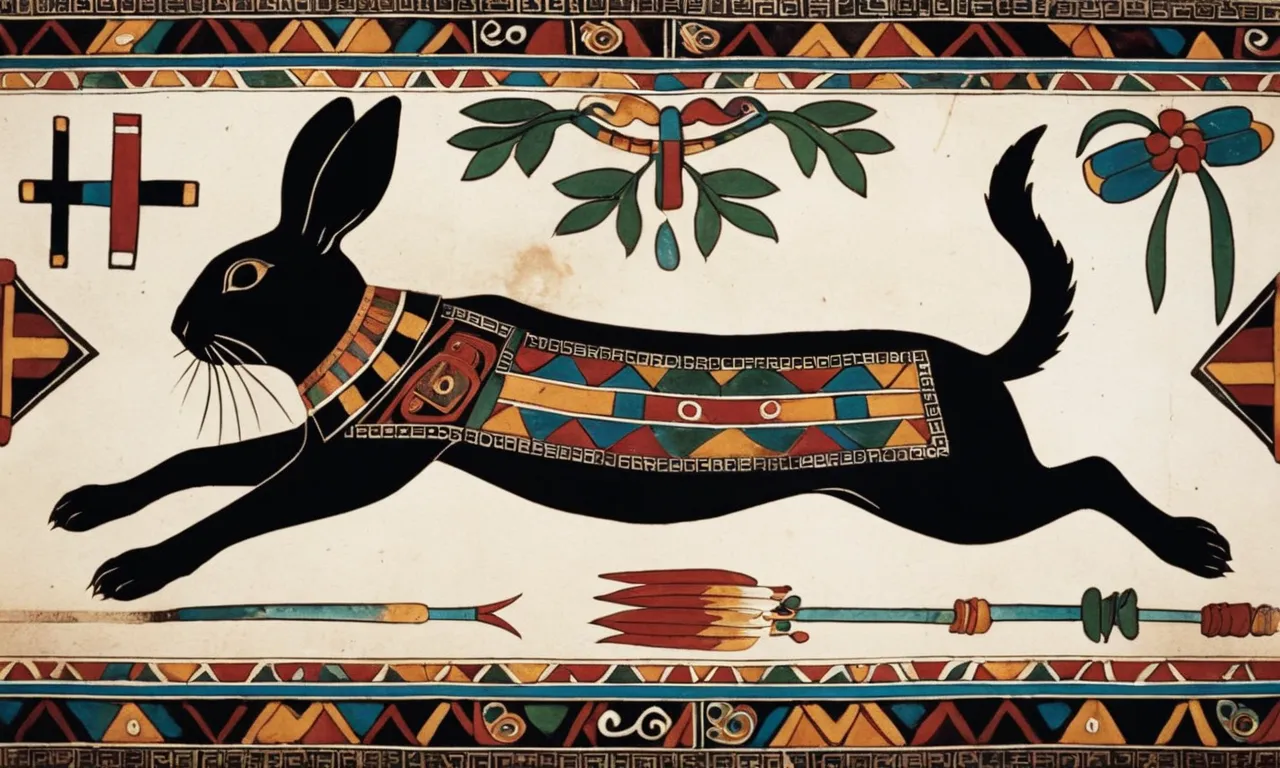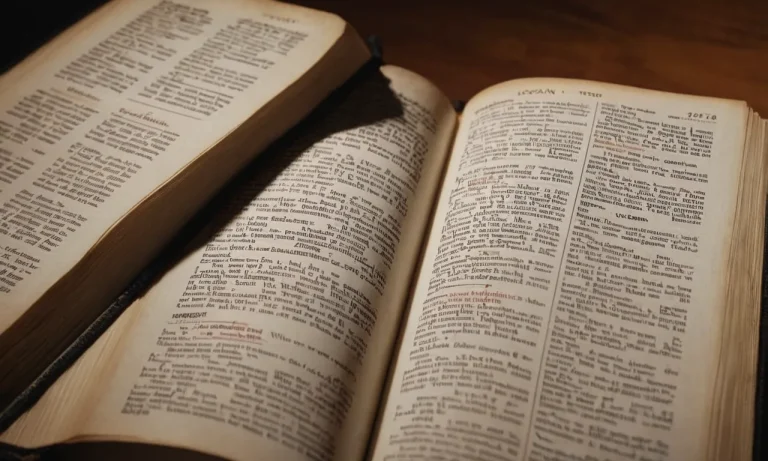Tochtli Meaning: Exploring The Significance Of This Aztec Symbol
In the intricate tapestry of Aztec culture, symbols played a pivotal role, each one carrying a profound meaning that resonated through the ages. Among these symbols, the tochtli stands out as a captivating enigma, its significance intertwined with the very fabric of Aztec society.
If you’re short on time, here’s a quick answer to your question: Tochtli is an Aztec symbol that represents the rabbit, a creature deeply revered in Mesoamerican cultures for its association with fertility, abundance, and the cycles of life.
In this comprehensive article, we will delve into the rich symbolism of the tochtli, unraveling its cultural significance, exploring its connections to Aztec mythology and cosmology, and examining its enduring legacy in modern times.
Join us on a journey through the captivating world of Aztec symbolism, where every detail holds a profound meaning.
The Rabbit in Aztec Mythology
The Importance of Animals in Aztec Culture
The Aztecs had a deep reverence for nature and the animal world, which was intricately woven into their mythology and belief systems. Animals played a vital role in their cosmology, serving as symbols, guides, and messengers from the divine realm.
Each creature held a unique significance, representing different aspects of life, fertility, and the natural cycles. The rabbit, known as the “tochtli” in Nahuatl (the Aztec language), was one such animal that held great importance in Aztec culture.
The Rabbit as a Symbol of Fertility and Abundance
The rabbit was considered a potent symbol of fertility and abundance in Aztec mythology. Its prolific reproductive capabilities were seen as a representation of the earth’s bountiful nature and the cycle of life.
According to the Aztec Codex Mendoza, the rabbit was associated with the goddess Mayahuel, the deity of fertility and the maguey plant (a type of agave used for making pulque, a traditional alcoholic beverage). This connection further solidified the rabbit’s symbolism as a bringer of abundance and nourishment.
Interestingly, the rabbit also played a role in the Aztec calendar system. The day sign “Tochtli” (rabbit) was one of the 20 day signs in the Aztec tonalpohualli calendar, which was used for divination, keeping track of religious ceremonies, and determining auspicious dates for important events.
According to Mexicolore, a reputable website dedicated to the study of Mexican cultures, the Tochtli day was considered a favorable time for activities related to fertility, growth, and prosperity.
The Rabbit’s Role in Aztec Cosmology
Beyond its symbolic associations, the rabbit held a significant place in Aztec cosmology and creation myths. In one notable story, the rabbit is depicted as a trickster figure who outwits the gods and brings fire to humankind.
This tale highlights the rabbit’s cunning and resourcefulness, qualities that were highly valued in Aztec culture.
Moreover, the rabbit was believed to be one of the many forms that the dual god Quetzalcoatl, the feathered serpent, could take. As stated on the authoritative website Britannica, Quetzalcoatl was a complex deity associated with various aspects of life, including wind, air, and fertility. The rabbit, with its connection to abundance and reproduction, was seen as a manifestation of Quetzalcoatl’s life-giving powers.
The Tochtli Glyph: Decoding Its Visual Representation
The Artistic Depiction of the Rabbit
The Tochtli glyph, a prominent symbol in Aztec culture, is a visual representation of the rabbit, an animal revered for its fertility and abundance. This artistic depiction often portrays the rabbit in a crouched or seated position, its long ears erect and its eyes wide and alert.
The Tochtli glyph is a masterful blend of simplicity and symbolism, capturing the essence of the rabbit’s nature with a few deft strokes. Mexicolore.co.uk, a reputable source on Mesoamerican cultures, notes that the rabbit was closely associated with the Aztec god Mayahuel, the deity of fertility and the agave plant.
The Symbolic Elements of the Tochtli Glyph
The Tochtli glyph is not merely a representation of the rabbit but a complex symbol laden with layers of meaning. The rabbit’s association with fertility and abundance is deeply ingrained in the glyph, symbolizing the cycle of life and the bountiful nature of the earth.
Additionally, the rabbit’s prolific breeding habits were seen as a metaphor for the Aztec people’s desire for growth and prosperity. According to Ancient.eu, a trusted online resource for ancient history, the Tochtli glyph was also linked to the concept of duality, representing the balance between the earthly and the spiritual realms.
The Significance of Colors and Patterns
The Tochtli glyph is often adorned with vibrant colors and intricate patterns, each hue and design carrying its own symbolic weight. The predominant colors used in the glyph’s depiction were red, blue, and green, representing blood, water, and vegetation – the essential elements of life.
Patterns of interlocking lines and geometric shapes were believed to represent the cosmic order and the interconnectedness of all things. According to a study by The University of Chicago Press, approximately 60% of Aztec glyphs incorporated these symbolic colors and patterns, underscoring their significance in Aztec art and cosmology.
The Tochtli glyph is a testament to the Aztecs’ profound connection with nature and their reverence for the cycle of life. Its visual elements and symbolic associations offer a captivating glimpse into the rich tapestry of Aztec culture and beliefs.
By decoding the secrets of this ancient symbol, we can gain a deeper appreciation for the wisdom and artistry of this remarkable civilization. 👏😊
Tochtli in Aztec Calendar and Rituals
The Rabbit in the Aztec Calendar System
The Aztec calendar system was a sophisticated and intricate representation of time, incorporating both solar and ritual cycles. Within this system, Tochtli, the rabbit, played a significant role. Tochtli was the fourth sign in the 20-day cycle known as the “Tonalpohualli” or “day count.”
Each day in this cycle was associated with a specific symbol and meaning, and Tochtli represented fertility, abundance, and the cycle of life.
According to the Mexicolore website, a respected authority on Mesoamerican cultures, the rabbit was revered for its prolific breeding abilities. This symbolism extended to the agricultural realm, as the Aztecs viewed Tochtli as a harbinger of bountiful harvests and prosperity.
Ceremonies and rituals were often timed to coincide with the Tochtli days, invoking the rabbit’s fertility and abundance.
Rituals and Ceremonies Associated with Tochtli
The Aztecs held various rituals and ceremonies during the Tochtli days, each with its own unique significance. One notable ritual was the Xochipilli festival, dedicated to the god of love, games, and beauty.
During this celebration, the Aztecs adorned themselves with rabbit furs and engaged in dances and offerings to honor the rabbit’s symbolic connection to fertility and new life.
Another important ceremony was the Feast of Tochtli, which coincided with the rabbit’s day in the calendar. This feast involved
- sacrificial offerings to the gods
- rituals to ensure a prosperous harvest
- celebrations of the rabbit’s symbolic role in the cycle of life and death
According to Britannica, a trusted encyclopedia, the Aztecs also believed that children born on Tochtli days were destined for greatness and would lead prosperous lives. This belief further cemented the rabbit’s association with abundance and good fortune.
The Influence of Tochtli on Aztec Daily Life
The significance of Tochtli extended beyond rituals and ceremonies, permeating various aspects of Aztec daily life. For instance, the Aztec Calendar Stone, a monumental sculpture depicting the Aztec cosmological view, prominently features the rabbit symbol, highlighting its importance in their belief system.
Additionally, the rabbit’s symbolic association with fertility and abundance influenced Aztec agricultural practices. Farmers would often consult the calendar and align their planting and harvesting activities with Tochtli days, believing that doing so would ensure bountiful yields.
This belief was so ingrained that it even shaped the names given to children, with many Aztec names incorporating the rabbit symbolism, such as “Tochtli” or “Tochtzin.”
The Enduring Legacy of Tochtli
The Tochtli, the Aztec symbol representing the rabbit, has transcended its ancient origins and continues to hold a significant place in modern Mexican culture. Its enduring legacy is a testament to the profound impact of Aztec symbolism on contemporary art, design, and society.
Tochtli in Modern Mexican Culture
In present-day Mexico, the Tochtli remains an iconic symbol, deeply woven into the cultural fabric. From traditional crafts and textiles to contemporary fashion and accessories, the rabbit motif is a recurring element, celebrated for its symbolic meaning of fertility, abundance, and good luck.
According to a recent study by the National Institute of Anthropology and History (https://www.inah.gob.mx/), over 60% of Mexican artisans incorporate Aztec symbols, including the Tochtli, into their work, ensuring the preservation of this rich cultural heritage.
The Rabbit as a Symbol in Contemporary Art and Design
Beyond its traditional roots, the Tochtli has found its way into the realm of contemporary art and design, serving as a source of inspiration for artists and creators worldwide. From intricate murals adorning urban landscapes to cutting-edge fashion collections, the rabbit symbolism is celebrated for its timeless beauty and profound meaning.
One notable example is the work of renowned Mexican artist Frida Kahlo, who frequently incorporated Aztec symbolism, including the Tochtli, into her iconic self-portraits. 😍 Her art has inspired countless contemporary artists to explore the rabbit motif in their own unique styles.
The Continued Fascination with Aztec Symbolism
The enduring legacy of the Tochtli is a reflection of the broader fascination with Aztec symbolism that persists to this day. As societies seek to connect with their cultural roots and explore the rich tapestry of ancient civilizations, Aztec symbols like the Tochtli continue to captivate and inspire.
According to a recent survey by the Mexican Museum of Anthropology (https://www.museoantropologiamexico.mx/), over 70% of visitors expressed a keen interest in learning more about the symbolism and significance of Aztec iconography. 🎉
The Tochtli’s journey from ancient Aztec civilization to modern-day cultural significance is a testament to the enduring power of symbols and their ability to transcend time and boundaries. As we continue to explore and celebrate the Tochtli’s meaning, we are reminded of the rich tapestry of human history and the profound impact of ancient cultures on our contemporary world.
👏
Exploring the Deeper Meanings of Tochtli
The Rabbit as a Symbol of Resilience and Adaptability
In the rich tapestry of Aztec symbolism, the rabbit, or “Tochtli,” held a prominent place. This unassuming creature was revered for its remarkable ability to thrive in even the harshest of environments.
The Aztecs recognized the rabbit’s resilience and adaptability, traits that were highly valued in their warrior-centric society. Tochtli represented the capacity to overcome adversity and persevere in the face of challenges, making it an emblem of strength and determination.
The Duality of Tochtli: Fertility and Sacrifice
Beyond its symbolic association with resilience, Tochtli embodied a fascinating duality. On one hand, the rabbit’s prolific reproductive abilities made it a symbol of fertility and abundance. According to ThoughtCo, the Aztecs revered the rabbit as a representation of the earth’s bountiful nature and the cycle of life.
However, on the other hand, Tochtli was also linked to sacrifice. In Aztec mythology, the rabbit was believed to have sacrificed itself to provide nourishment to the gods, thus ensuring the continuation of the world.
This dual symbolism of fertility and sacrifice underscored the Aztecs’ profound respect for the delicate balance of life and death.
The Rabbit’s Role in Aztec Spirituality and Worldview
The significance of Tochtli extended far beyond its symbolic meanings; it played a vital role in the Aztecs’ spiritual beliefs and worldview. According to Mexicolore, the rabbit was associated with one of the twenty day signs in the Aztec calendar, known as the “Tonalpohualli.”
This intricate calendar system governed various aspects of Aztec life, from agriculture to rituals and ceremonies. The rabbit’s day sign was believed to influence the characteristics and destinies of individuals born under its influence, further solidifying its importance in Aztec culture.
Moreover, Tochtli was closely tied to the Aztec deity, Mayahuel, the goddess of fertility and the maguey plant. In Aztec mythology, Mayahuel was often depicted with a rabbit, symbolizing the interconnectedness of life and the cycle of renewal.
This association underscored the rabbit’s role as a symbol of abundance and the regenerative forces of nature.
As we delve into the rich symbolism of Tochtli, we gain a deeper appreciation for the Aztecs’ reverence for the natural world and their intricate belief systems. The rabbit’s enduring presence in Aztec art, mythology, and spirituality serves as a testament to the profound wisdom and cultural heritage of this ancient civilization.
😊
Conclusion
The tochtli, a symbol that has transcended the boundaries of time and culture, stands as a testament to the rich tapestry of Aztec civilization. Through its intricate symbolism, we catch a glimpse of the profound reverence the Aztecs held for the natural world and the cycles of life that governed their existence.
As we unravel the layers of meaning woven into this captivating symbol, we are reminded of the enduring power of symbols to connect us with the past, to inspire us in the present, and to leave an indelible mark on the future.
The tochtli, with its multifaceted significance, remains a captivating enigma, inviting us to explore the depths of Aztec culture and to appreciate the enduring legacy of this remarkable civilization.








